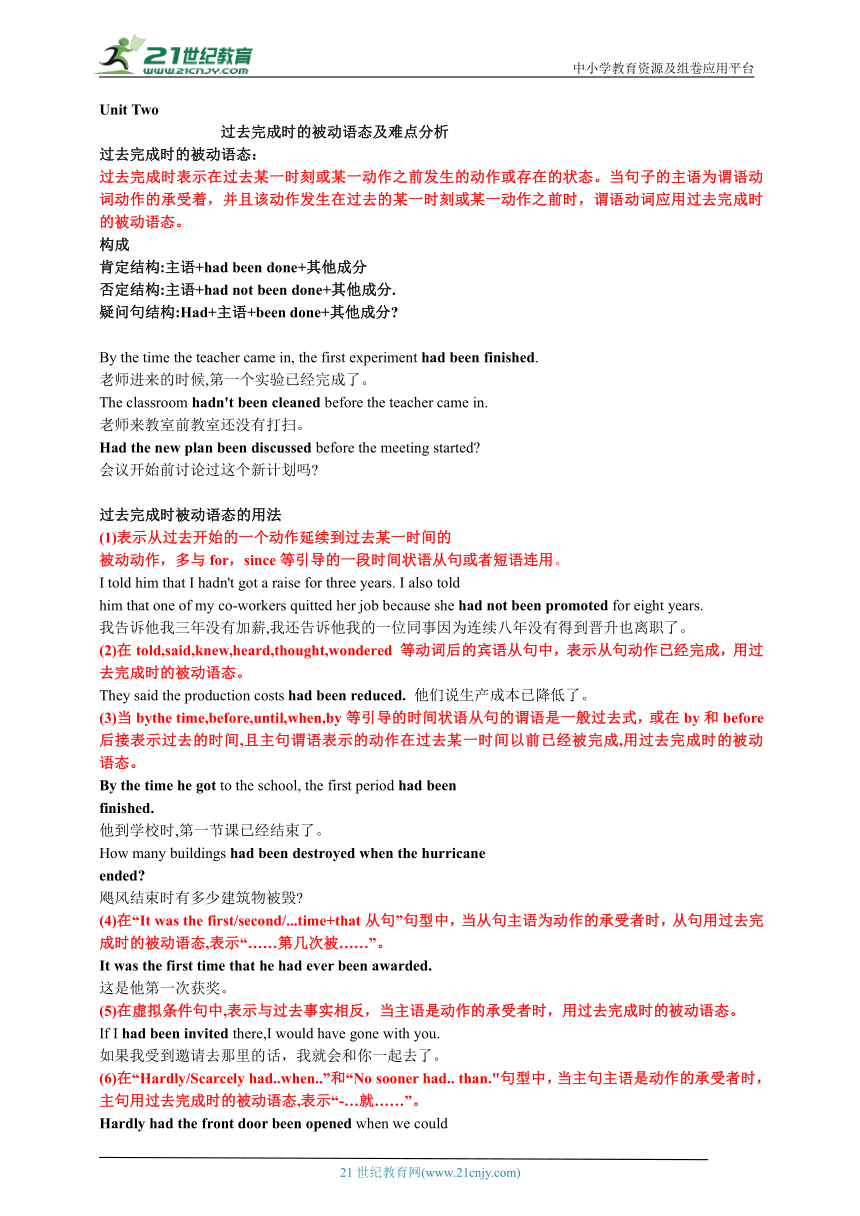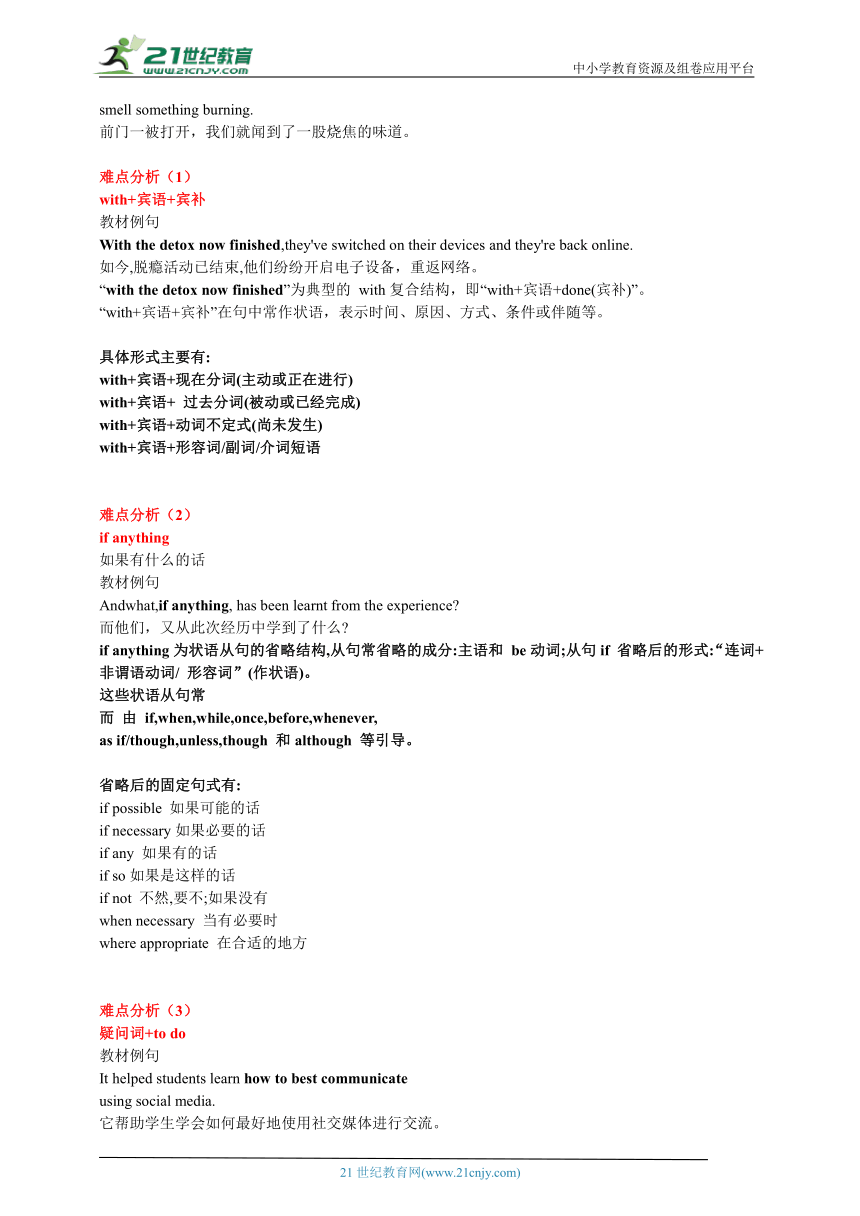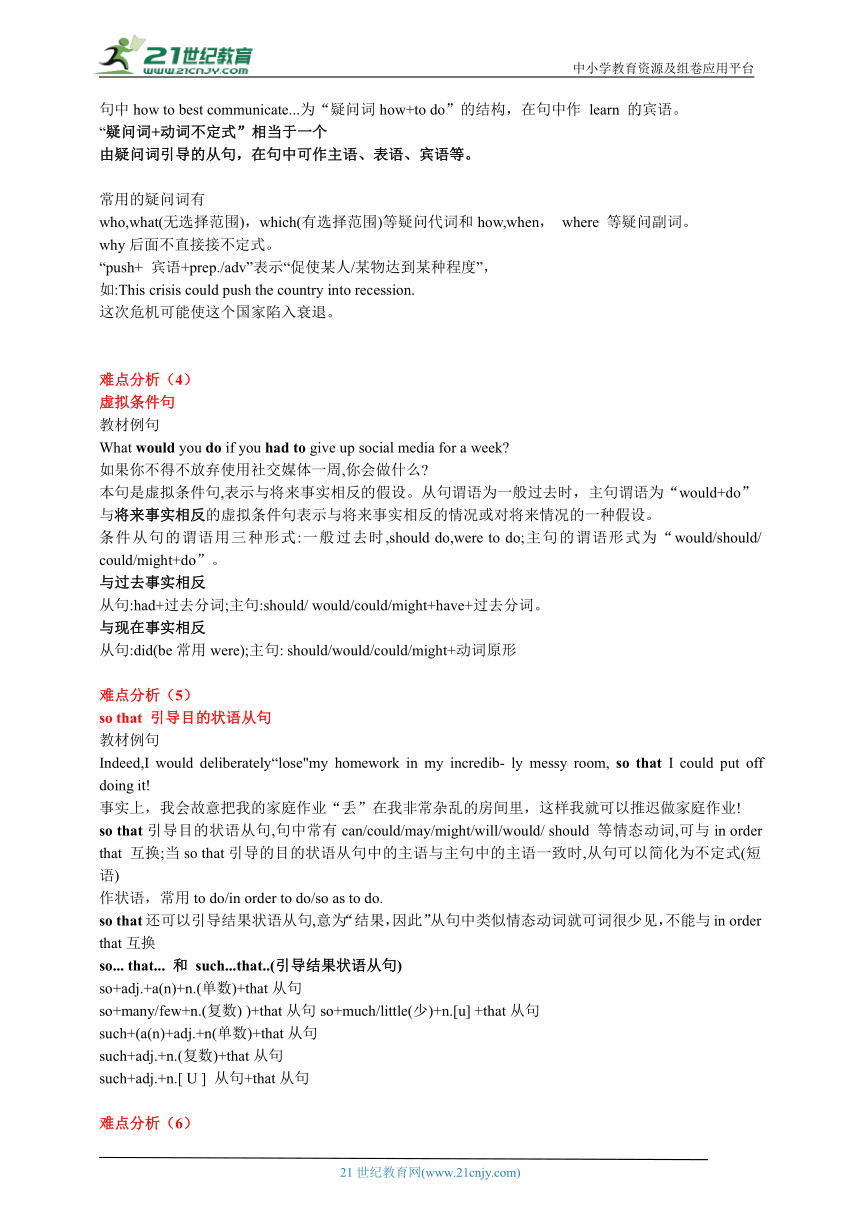(2019外研版)选修二Unit 2 Improving yourself(精讲)
文档属性
| 名称 | (2019外研版)选修二Unit 2 Improving yourself(精讲) |  | |
| 格式 | doc | ||
| 文件大小 | 281.3KB | ||
| 资源类型 | 试卷 | ||
| 版本资源 | 外研版(2019) | ||
| 科目 | 英语 | ||
| 更新时间 | 2024-05-06 18:52:46 | ||
图片预览



文档简介
中小学教育资源及组卷应用平台
Unit Two
过去完成时的被动语态及难点分析
过去完成时的被动语态:
过去完成时表示在过去某一时刻或某一动作之前发生的动作或存在的状态。当句子的主语为谓语动词动作的承受着,并且该动作发生在过去的某一时刻或某一动作之前时,谓语动词应用过去完成时的被动语态。
构成
肯定结构:主语+had been done+其他成分
否定结构:主语+had not been done+其他成分.
疑问句结构:Had+主语+been done+其他成分
By the time the teacher came in, the first experiment had been finished.
老师进来的时候,第一个实验已经完成了。
The classroom hadn't been cleaned before the teacher came in.
老师来教室前教室还没有打扫。
Had the new plan been discussed before the meeting started
会议开始前讨论过这个新计划吗
过去完成时被动语态的用法
(1)表示从过去开始的一个动作延续到过去某一时间的
被动动作,多与for,since等引导的一段时间状语从句或者短语连用。
I told him that I hadn't got a raise for three years. I also told
him that one of my co-workers quitted her job because she had not been promoted for eight years.
我告诉他我三年没有加薪,我还告诉他我的一位同事因为连续八年没有得到晋升也离职了。
(2)在told,said,knew,heard,thought,wondered 等动词后的宾语从句中,表示从句动作已经完成,用过去完成时的被动语态。
They said the production costs had been reduced. 他们说生产成本已降低了。
(3)当bythe time,before,until,when,by等引导的时间状语从句的谓语是一般过去式,或在by和before后接表示过去的时间,且主句谓语表示的动作在过去某一时间以前已经被完成,用过去完成时的被动语态。
By the time he got to the school, the first period had been
finished.
他到学校时,第一节课已经结束了。
How many buildings had been destroyed when the hurricane
ended
飓风结束时有多少建筑物被毁
(4)在“It was the first/second/...time+that从句”句型中,当从句主语为动作的承受者时,从句用过去完成时的被动语态,表示“……第几次被……”。
It was the first time that he had ever been awarded.
这是他第一次获奖。
(5)在虚拟条件句中,表示与过去事实相反,当主语是动作的承受者时,用过去完成时的被动语态。
If I had been invited there,I would have gone with you.
如果我受到邀请去那里的话,我就会和你一起去了。
(6)在“Hardly/Scarcely had..when..”和“No sooner had.. than."句型中,当主句主语是动作的承受者时,主句用过去完成时的被动语态,表示“-…就……”。
Hardly had the front door been opened when we could
smell something burning.
前门一被打开,我们就闻到了一股烧焦的味道。
难点分析(1)
with+宾语+宾补
教材例句
With the detox now finished,they've switched on their devices and they're back online.
如今,脱瘾活动已结束,他们纷纷开启电子设备,重返网络。
“with the detox now finished”为典型的 with复合结构,即“with+宾语+done(宾补)”。
“with+宾语+宾补”在句中常作状语,表示时间、原因、方式、条件或伴随等。
具体形式主要有:
with+宾语+现在分词(主动或正在进行)
with+宾语+ 过去分词(被动或已经完成)
with+宾语+动词不定式(尚未发生)
with+宾语+形容词/副词/介词短语
难点分析(2)
if anything
如果有什么的话
教材例句
Andwhat,if anything, has been learnt from the experience
而他们,又从此次经历中学到了什么
if anything为状语从句的省略结构,从句常省略的成分:主语和 be动词;从句if 省略后的形式:“连词+非谓语动词/ 形容词”(作状语)。
这些状语从句常
而 由 if,when,while,once,before,whenever,
as if/though,unless,though 和although 等引导。
省略后的固定句式有:
if possible 如果可能的话
if necessary如果必要的话
if any 如果有的话
if so如果是这样的话
if not 不然,要不;如果没有
when necessary 当有必要时
where appropriate 在合适的地方
难点分析(3)
疑问词+to do
教材例句
It helped students learn how to best communicate
using social media.
它帮助学生学会如何最好地使用社交媒体进行交流。
句中how to best communicate...为“疑问词how+to do”的结构,在句中作 learn 的宾语。
“疑问词+动词不定式”相当于一个
由疑问词引导的从句,在句中可作主语、表语、宾语等。
常用的疑问词有
who,what(无选择范围),which(有选择范围)等疑问代词和how,when, where 等疑问副词。
why后面不直接接不定式。
“push+ 宾语+prep./adv”表示“促使某人/某物达到某种程度”,
如:This crisis could push the country into recession.
这次危机可能使这个国家陷入衰退。
难点分析(4)
虚拟条件句
教材例句
What would you do if you had to give up social media for a week
如果你不得不放弃使用社交媒体一周,你会做什么
本句是虚拟条件句,表示与将来事实相反的假设。从句谓语为一般过去时,主句谓语为“would+do”
与将来事实相反的虚拟条件句表示与将来事实相反的情况或对将来情况的一种假设。
条件从句的谓语用三种形式:一般过去时,should do,were to do;主句的谓语形式为“would/should/ could/might+do”。
与过去事实相反
从句:had+过去分词;主句:should/ would/could/might+have+过去分词。
与现在事实相反
从句:did(be常用were);主句: should/would/could/might+动词原形
难点分析(5)
so that 引导目的状语从句
教材例句
Indeed,I would deliberately“lose"my homework in my incredib- ly messy room, so that I could put off doing it!
事实上,我会故意把我的家庭作业“丢”在我非常杂乱的房间里,这样我就可以推迟做家庭作业!
so that引导目的状语从句,句中常有can/could/may/might/will/would/ should 等情态动词,可与in order that 互换;当so that引导的目的状语从句中的主语与主句中的主语一致时,从句可以简化为不定式(短语)
作状语,常用to do/in order to do/so as to do.
so that还可以引导结果状语从句,意为“结果,因此”从句中类似情态动词就可词很少见,不能与in order that互换
so... that... 和 such...that..(引导结果状语从句)
so+adj.+a(n)+n.(单数)+that从句
so+many/few+n.(复数) )+that从句so+much/little(少)+n.[u] +that从句
such+(a(n)+adj.+n(单数)+that从句
such+adj.+n.(复数)+that从句
such+adj.+n.[ U ] 从句+that从句
难点分析(6)
过去分词置于句首引起的倒装
数材例句
Printed on each umbrella was a short statement abou..
每把伞上都印有关于……的简短的文字。
①有时主语较长,为保持句子平衡或强调或使上下文衔接紧密,可把介词短语、形容词或分词提到句首,并把句子的主语和谓语完全倒装。
On her left sat her husband.
她左边坐着她的丈夫。
Standing on the stage is a super star.
站在舞台上的是一位超级明星。
Buried in the sands was an ancient village.
被埋于沙土之下的是一个古老的村子。
②here,there等方位副词及now,then等时间副词位于句首,句子谓语动词为come,go,leave,run 等表示动作趋向或状态(be)的动词时,句子的主语和谓语完全倒装。
Now comes your turn.现在该你了。
③there be句型属于完全倒装结构,该句型中be还可appear,lie,live,
stand,remain,exist等表示存在的动词替换。
There lived a cruel king in the castle.
那座城堡里曾住着一位残忍的国王。
④副词 away,down,in,off,out, over,round,up等位于句首时,其后也用完全倒装语序,这类倒装句的谓语通常是表示动态的不及物动词。
Away went the runners.
赛车选手们跑远了。
难点分析(7)
on/upon+doing 一……就……
教材例句
On receiving a Kare Bag,one woman said,“You make me feel like a human being.”
在收到“爱心包包”时,一位女士说:“你让我觉得自己活得像个人。
on/upon+n./v-ing是介词短语,表示“一……就……”,作时间状语。 on /upon her reaching the new place她一到达这个新地方
“一……就……”的其他表达法:
at the sight/sound of.. 一看见/听见……
the moment/minute/instant/second(名词用作连词)+句子immediately/instantly/directly(副词用作连词)+句子hardly/scarcely...when...
no sooner... than...
as soon as 一……就……(引导时间状语从句)
难点分析(8)
that 引导表语从句
教材例句
The value taught with the Spending jar is that you are responsible for your own happiness.
“消费”罐子传递的价值是,你要为自己的幸福负责。
that/what引导表语从句的区别
that 引导表语从句时,在从句中不作任何成分,也无实际意义,只起连接作用,但不可省略。
what引导表语从句时,在从句中可以作主语、宾语或表语,what表示的事物”,相当于the thing(s )that.
难点分析(9)
while 用作并列连词
教材例句
While the Spending jar is about the here and now, the Saving jar gives you a vision for the future.
“消费”罐子关注的是眼前和当下,而“储蓄”罐子则为你提供了未来的愿景。
while 表示对比,意为“而”“但”。
I went swimming while the others played tennis.
我去游泳,而其余的人则去打网球了。
这样用时,while引出的句子通常位于句末,但有时也可位于句首。课文中就是该用法。
While most children learn to read easily, some need extra help.
大多数儿童学会阅读很容易,有一些儿童却需要额外帮助。
while引导让步状语从句,表示“尽管”“虽然”。
While the work was difficult, it was interesting.
虽然工作有难度,但很有趣。
while 引导时间状语从句。
Were there any calls for me while l was out
我出去的时候,有人给我来电话吗
难点分析(10)
every time引导时间状语从句
教材例句
His father gave him a bag of nails and told him that every time he lost his temper, he must hammer a nail into the back of the fence.
他的父亲给了他一包钉子,并告诉他,每次他发脾气时,他都要把一颗钉子钉进篱笆的后面。
every time 相当于each time,意为“每次”是名词词组,可用作连词,引导时间状语从句。
例:The roof leaks every time it rains.
每逢下雨屋顶都会漏水。
除every time外,下列名词词组也可以引导时间状语从句:
the first/second time第一次/第二次
(the)last time/(the)next time上次/下次
any time 任何时候
the day/week/month/year. 那天/那星期/那个月/那年……
the moment...……就……
本单元词组
1.be persuaded to do 被劝做...
2.on/upon reflection经再三考虑;反思
3.miss out错过;错失
4.check out 查看;观察;看一看
5.throw in the towel 认输
6.awareness of 意识到;对...的意识
7.vary from...to 从...到...变化
8.max out (钱)花光;(信用卡)刷爆
9.barrier to 对...的阻碍;障碍
10.the here and now 眼前;现在;此时此地
11.switch on (用开关)开;打开
12.be occupied with 忙于...
13.be distracted by 被...分心
14.be embarrassed to do 因做... 而感到尴尬
15.without access to 享受不到;不能接触到
16.step away from 逃避;远离
17.rely on 依靠;依赖
18.in contrast to 与...形成对比
19.in control of 管理;控制‘
20.put aside 把...放到一边;搁置
21.resist temptation 抵制诱惑
22.fail to do sth.未能做某事
23.on average 平均起来
24.a total of 共计...
25.pick up (偶然)学会;得到
26.be up to 正在做;忙于
27.give in 投降;屈服;让步
28.tired out 疲惫不堪的
29.catch up 赶上;得到...消息;弥补;打听(不在时所发生的事情),别后叙谈
30.other than 除了;除...之外(常用于否定结构中);不同于
31.take up占用(时间)
32. turn over 翻转
33.be careless about 对...不在意
34.put off 推迟;延期
35.work out 解决(问题);找到解决办法;制定(规则,计划等)
e up with(=put forward或bring forward) 提出;想出(人作主语,无被动语态和进行时态)
37.do with 处理
38.intend to do sth.打算做某事
39.help out 帮一把;帮...解决难题或摆脱困境
40.in addition (to sb./sth.)除...以外(还)
41.pass by 经过;走过;逝去
21世纪教育网 www.21cnjy.com 精品试卷·第 2 页 (共 2 页)
21世纪教育网(www.21cnjy.com)
Unit Two
过去完成时的被动语态及难点分析
过去完成时的被动语态:
过去完成时表示在过去某一时刻或某一动作之前发生的动作或存在的状态。当句子的主语为谓语动词动作的承受着,并且该动作发生在过去的某一时刻或某一动作之前时,谓语动词应用过去完成时的被动语态。
构成
肯定结构:主语+had been done+其他成分
否定结构:主语+had not been done+其他成分.
疑问句结构:Had+主语+been done+其他成分
By the time the teacher came in, the first experiment had been finished.
老师进来的时候,第一个实验已经完成了。
The classroom hadn't been cleaned before the teacher came in.
老师来教室前教室还没有打扫。
Had the new plan been discussed before the meeting started
会议开始前讨论过这个新计划吗
过去完成时被动语态的用法
(1)表示从过去开始的一个动作延续到过去某一时间的
被动动作,多与for,since等引导的一段时间状语从句或者短语连用。
I told him that I hadn't got a raise for three years. I also told
him that one of my co-workers quitted her job because she had not been promoted for eight years.
我告诉他我三年没有加薪,我还告诉他我的一位同事因为连续八年没有得到晋升也离职了。
(2)在told,said,knew,heard,thought,wondered 等动词后的宾语从句中,表示从句动作已经完成,用过去完成时的被动语态。
They said the production costs had been reduced. 他们说生产成本已降低了。
(3)当bythe time,before,until,when,by等引导的时间状语从句的谓语是一般过去式,或在by和before后接表示过去的时间,且主句谓语表示的动作在过去某一时间以前已经被完成,用过去完成时的被动语态。
By the time he got to the school, the first period had been
finished.
他到学校时,第一节课已经结束了。
How many buildings had been destroyed when the hurricane
ended
飓风结束时有多少建筑物被毁
(4)在“It was the first/second/...time+that从句”句型中,当从句主语为动作的承受者时,从句用过去完成时的被动语态,表示“……第几次被……”。
It was the first time that he had ever been awarded.
这是他第一次获奖。
(5)在虚拟条件句中,表示与过去事实相反,当主语是动作的承受者时,用过去完成时的被动语态。
If I had been invited there,I would have gone with you.
如果我受到邀请去那里的话,我就会和你一起去了。
(6)在“Hardly/Scarcely had..when..”和“No sooner had.. than."句型中,当主句主语是动作的承受者时,主句用过去完成时的被动语态,表示“-…就……”。
Hardly had the front door been opened when we could
smell something burning.
前门一被打开,我们就闻到了一股烧焦的味道。
难点分析(1)
with+宾语+宾补
教材例句
With the detox now finished,they've switched on their devices and they're back online.
如今,脱瘾活动已结束,他们纷纷开启电子设备,重返网络。
“with the detox now finished”为典型的 with复合结构,即“with+宾语+done(宾补)”。
“with+宾语+宾补”在句中常作状语,表示时间、原因、方式、条件或伴随等。
具体形式主要有:
with+宾语+现在分词(主动或正在进行)
with+宾语+ 过去分词(被动或已经完成)
with+宾语+动词不定式(尚未发生)
with+宾语+形容词/副词/介词短语
难点分析(2)
if anything
如果有什么的话
教材例句
Andwhat,if anything, has been learnt from the experience
而他们,又从此次经历中学到了什么
if anything为状语从句的省略结构,从句常省略的成分:主语和 be动词;从句if 省略后的形式:“连词+非谓语动词/ 形容词”(作状语)。
这些状语从句常
而 由 if,when,while,once,before,whenever,
as if/though,unless,though 和although 等引导。
省略后的固定句式有:
if possible 如果可能的话
if necessary如果必要的话
if any 如果有的话
if so如果是这样的话
if not 不然,要不;如果没有
when necessary 当有必要时
where appropriate 在合适的地方
难点分析(3)
疑问词+to do
教材例句
It helped students learn how to best communicate
using social media.
它帮助学生学会如何最好地使用社交媒体进行交流。
句中how to best communicate...为“疑问词how+to do”的结构,在句中作 learn 的宾语。
“疑问词+动词不定式”相当于一个
由疑问词引导的从句,在句中可作主语、表语、宾语等。
常用的疑问词有
who,what(无选择范围),which(有选择范围)等疑问代词和how,when, where 等疑问副词。
why后面不直接接不定式。
“push+ 宾语+prep./adv”表示“促使某人/某物达到某种程度”,
如:This crisis could push the country into recession.
这次危机可能使这个国家陷入衰退。
难点分析(4)
虚拟条件句
教材例句
What would you do if you had to give up social media for a week
如果你不得不放弃使用社交媒体一周,你会做什么
本句是虚拟条件句,表示与将来事实相反的假设。从句谓语为一般过去时,主句谓语为“would+do”
与将来事实相反的虚拟条件句表示与将来事实相反的情况或对将来情况的一种假设。
条件从句的谓语用三种形式:一般过去时,should do,were to do;主句的谓语形式为“would/should/ could/might+do”。
与过去事实相反
从句:had+过去分词;主句:should/ would/could/might+have+过去分词。
与现在事实相反
从句:did(be常用were);主句: should/would/could/might+动词原形
难点分析(5)
so that 引导目的状语从句
教材例句
Indeed,I would deliberately“lose"my homework in my incredib- ly messy room, so that I could put off doing it!
事实上,我会故意把我的家庭作业“丢”在我非常杂乱的房间里,这样我就可以推迟做家庭作业!
so that引导目的状语从句,句中常有can/could/may/might/will/would/ should 等情态动词,可与in order that 互换;当so that引导的目的状语从句中的主语与主句中的主语一致时,从句可以简化为不定式(短语)
作状语,常用to do/in order to do/so as to do.
so that还可以引导结果状语从句,意为“结果,因此”从句中类似情态动词就可词很少见,不能与in order that互换
so... that... 和 such...that..(引导结果状语从句)
so+adj.+a(n)+n.(单数)+that从句
so+many/few+n.(复数) )+that从句so+much/little(少)+n.[u] +that从句
such+(a(n)+adj.+n(单数)+that从句
such+adj.+n.(复数)+that从句
such+adj.+n.[ U ] 从句+that从句
难点分析(6)
过去分词置于句首引起的倒装
数材例句
Printed on each umbrella was a short statement abou..
每把伞上都印有关于……的简短的文字。
①有时主语较长,为保持句子平衡或强调或使上下文衔接紧密,可把介词短语、形容词或分词提到句首,并把句子的主语和谓语完全倒装。
On her left sat her husband.
她左边坐着她的丈夫。
Standing on the stage is a super star.
站在舞台上的是一位超级明星。
Buried in the sands was an ancient village.
被埋于沙土之下的是一个古老的村子。
②here,there等方位副词及now,then等时间副词位于句首,句子谓语动词为come,go,leave,run 等表示动作趋向或状态(be)的动词时,句子的主语和谓语完全倒装。
Now comes your turn.现在该你了。
③there be句型属于完全倒装结构,该句型中be还可appear,lie,live,
stand,remain,exist等表示存在的动词替换。
There lived a cruel king in the castle.
那座城堡里曾住着一位残忍的国王。
④副词 away,down,in,off,out, over,round,up等位于句首时,其后也用完全倒装语序,这类倒装句的谓语通常是表示动态的不及物动词。
Away went the runners.
赛车选手们跑远了。
难点分析(7)
on/upon+doing 一……就……
教材例句
On receiving a Kare Bag,one woman said,“You make me feel like a human being.”
在收到“爱心包包”时,一位女士说:“你让我觉得自己活得像个人。
on/upon+n./v-ing是介词短语,表示“一……就……”,作时间状语。 on /upon her reaching the new place她一到达这个新地方
“一……就……”的其他表达法:
at the sight/sound of.. 一看见/听见……
the moment/minute/instant/second(名词用作连词)+句子immediately/instantly/directly(副词用作连词)+句子hardly/scarcely...when...
no sooner... than...
as soon as 一……就……(引导时间状语从句)
难点分析(8)
that 引导表语从句
教材例句
The value taught with the Spending jar is that you are responsible for your own happiness.
“消费”罐子传递的价值是,你要为自己的幸福负责。
that/what引导表语从句的区别
that 引导表语从句时,在从句中不作任何成分,也无实际意义,只起连接作用,但不可省略。
what引导表语从句时,在从句中可以作主语、宾语或表语,what表示的事物”,相当于the thing(s )that.
难点分析(9)
while 用作并列连词
教材例句
While the Spending jar is about the here and now, the Saving jar gives you a vision for the future.
“消费”罐子关注的是眼前和当下,而“储蓄”罐子则为你提供了未来的愿景。
while 表示对比,意为“而”“但”。
I went swimming while the others played tennis.
我去游泳,而其余的人则去打网球了。
这样用时,while引出的句子通常位于句末,但有时也可位于句首。课文中就是该用法。
While most children learn to read easily, some need extra help.
大多数儿童学会阅读很容易,有一些儿童却需要额外帮助。
while引导让步状语从句,表示“尽管”“虽然”。
While the work was difficult, it was interesting.
虽然工作有难度,但很有趣。
while 引导时间状语从句。
Were there any calls for me while l was out
我出去的时候,有人给我来电话吗
难点分析(10)
every time引导时间状语从句
教材例句
His father gave him a bag of nails and told him that every time he lost his temper, he must hammer a nail into the back of the fence.
他的父亲给了他一包钉子,并告诉他,每次他发脾气时,他都要把一颗钉子钉进篱笆的后面。
every time 相当于each time,意为“每次”是名词词组,可用作连词,引导时间状语从句。
例:The roof leaks every time it rains.
每逢下雨屋顶都会漏水。
除every time外,下列名词词组也可以引导时间状语从句:
the first/second time第一次/第二次
(the)last time/(the)next time上次/下次
any time 任何时候
the day/week/month/year. 那天/那星期/那个月/那年……
the moment...……就……
本单元词组
1.be persuaded to do 被劝做...
2.on/upon reflection经再三考虑;反思
3.miss out错过;错失
4.check out 查看;观察;看一看
5.throw in the towel 认输
6.awareness of 意识到;对...的意识
7.vary from...to 从...到...变化
8.max out (钱)花光;(信用卡)刷爆
9.barrier to 对...的阻碍;障碍
10.the here and now 眼前;现在;此时此地
11.switch on (用开关)开;打开
12.be occupied with 忙于...
13.be distracted by 被...分心
14.be embarrassed to do 因做... 而感到尴尬
15.without access to 享受不到;不能接触到
16.step away from 逃避;远离
17.rely on 依靠;依赖
18.in contrast to 与...形成对比
19.in control of 管理;控制‘
20.put aside 把...放到一边;搁置
21.resist temptation 抵制诱惑
22.fail to do sth.未能做某事
23.on average 平均起来
24.a total of 共计...
25.pick up (偶然)学会;得到
26.be up to 正在做;忙于
27.give in 投降;屈服;让步
28.tired out 疲惫不堪的
29.catch up 赶上;得到...消息;弥补;打听(不在时所发生的事情),别后叙谈
30.other than 除了;除...之外(常用于否定结构中);不同于
31.take up占用(时间)
32. turn over 翻转
33.be careless about 对...不在意
34.put off 推迟;延期
35.work out 解决(问题);找到解决办法;制定(规则,计划等)
e up with(=put forward或bring forward) 提出;想出(人作主语,无被动语态和进行时态)
37.do with 处理
38.intend to do sth.打算做某事
39.help out 帮一把;帮...解决难题或摆脱困境
40.in addition (to sb./sth.)除...以外(还)
41.pass by 经过;走过;逝去
21世纪教育网 www.21cnjy.com 精品试卷·第 2 页 (共 2 页)
21世纪教育网(www.21cnjy.com)
